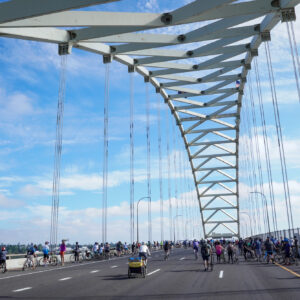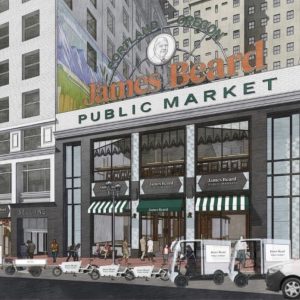Length: 8 min. 12 sec.
Clarence Eckerson’s latest StreetFilms piece focuses on Berkeley California’s bicycle boulevard network. It’s a great film and it shows that Berkeley is way ahead of Portland in creating slow, traffic-calmed streets that are safe and appealing for people (not just cars).
Three things Berkeley has that I’d love to see in Portland:
- They seem to have an entire, connected network of them.
- They use a consistent and unique color (Purple) on the main street signs and on special “Bicycle Boulevard” signs.
- They have huge symbols on the streets that have a bike icon, “BLVD” then an arrow. These make it absolutely clear to everyone to expect bicycles and slower traffic on these streets.
Someday I hope Portland’s dream to have more streets like these becomes a reality. Check out what the BTA is doing to make this happen.





Thanks for reading.
BikePortland has served this community with independent community journalism since 2005. We rely on subscriptions from readers like you to survive. Your financial support is vital in keeping this valuable resource alive and well.
Please subscribe today to strengthen and expand our work.
Mmmmmmm, Bike Boulevards.
All I know is that I love riding on Ankeny and I’d love to have more streets like that.
My pipe dream? An eastside, North/South route that has a bike/ped bridge to get over 84.
Something west of 30ish.
Actually I’d call Portland and Berkeley about tied. I like Bike Boulevards (BBs) everywhere, cause we have nothing like it here in NYC!
Where the BBs in Portland seem to have been planned rather carefully and strategically, the BBs in Berkeley have more been a result of carefully chosen streets based upon (mostly) pre-existing traffic calming installed up thru the 1980s. (Though Milvia Street is nice and as Dave Campbell pointed out there are a large number of new traffic circles being installed on BBs).
Still every time I am riding there and I come across those omnipresent traffic diverters with the car-stopping staples in the ground it makes me smile.
Oh, and the purple-ness and stencils can’t be beat.
Wonderful video! I can’t wait for this in Chicago. It would really help around the University of Illinois at Chicago because we are bordered on the north and east by two main highways and large feeder roads. At certain times of the day, these highways are fed by Roosevelt Rd. and Harrison St. running east-west, and Halsted St. running north-south. Sometimes the even smaller street of Morgan (with parking on both sides) has cars greatly speeding up to cover the really short distance in a shorter amount of time.
All of the roads mentioned are the main bike thoroughfares to the campus. Additionally, the bike lanes on these roads were removed to give more space to cars because of the major delays that were predicted by the Interstate 90/94 reconstruction. Major traffic delays haven’t materialized and I’m guessing that the bike lanes are purposely forgotten.
Bike boulevard’s could be a step in the right direction. We need more inspiring and unordinary city planning. Take a look at ecocitybuilders.org who are also based in Berkeley. And if Berkeley inspires you take a look at Berkeley’s role model, David California. I love Portland and peddle it’s puddles often, however we have alot to learn from the two cities noted above. How about having the Office of Sustainable Development keep track of the number of car-free people or families that reside in Portland? It would be a start.
Couch is an interesting example against Ankeny – the stop signs are not set up right and there are no diverters. While there seems not to be much traffic (cars) there is little bike traffic either.
Also… seems the video clip is gone from YouTube or its been overwhelmed…
Great video. It’s been ages since I lived there, but I remember the blocked streets from when I was a little kid. Cool that they have evolved that into such an extensive network.
Other than issues involving budget, I must admit I do not see why these have not been more widespread in Portland. If I lived on a street targeted for this kind of treatment, I would jump at the chance to lower traffic on “my street”. As in Berkeley, residents in a given area just learn the correct way to ingress and egress from their street. With MapQuest and Nav systems, your friends don’t even have to get lost anymore. Go Purple!
I hate to do this, but it’s time to remind the bike community of the difference between “it’s” and “its.”
it’s = it is
its = the possessive of it
And stop using apostrophes in plurals, please. Every time I see one, it feels like I just broke my chain. I’ll shut up now, and we can all return to the topic, better practitioners of our keyboards, I hope.
As a cyclist who lived in Berkeley for 10 years, I’ve pedaled all the avenues in the video and would have held them up as a model for cyclists. That is until I moved to Portland two years ago and discovered the bike network here. They both have strengths, but neither is perfect and Portland’s has far greater potential.
The strength of Berkeley’s system is the traffic calming efforts that benefit cyclists. These were installed without cyclists in mind, though the Bike Coalition has wisely exploited this infrastructure (at last, unintended consequences work in favor of cyclists!). Without the traffic-calming infrastructure, the system would significantly less beneficial to cyclists. A similar traffic-calming program in Portland would be a boon for the livability of entire neighborhoods, not just cyclists.
One significant difference between Berkeley and Portland is scale. The entire Berkeley bike boulevard network covers an area an area about the size of inner southeast Portland. As any East Bay cyclist will tell you, the bike boulevards are great, unless you need to get to Oakland, Richmond, Albany, El Cerrito, or any of the other adjacent cities. For a comparison, consider how bike-friendly Portland would be if the bike network was limited to the area between SE Holgate and NE Broadway and the 39th Ave and the river. The Berkeley system is great in many ways, but it has a Disneyland quality; if you want to leave the magic kingdom of Berkeley, you take your life in your hands.
Another apparent innovation in Berkeley is the signage and on-street stenciling. If nothing else, it makes on-bike navigation much easier. In theory, it also raises the profile of cyclists with motorists. However, I’ve felt far less threatened pedaling along Hwy 43 in Portland (no bike lane) than I have along Milvia or Hillegass in Berkeley. This likely has more to do with the temperament of the drivers in each location (e.g., California has more asshole drivers).
Also, the much vaunted, bike signal at MLK in Berkeley. It’s a great idea, but in practice, it’s no better or worse than the bike only crossing at SE Clinton and SE 39th.
Though Berkeley’s bike boulevard network is admirable and has many practices and concepts that could be adopted in Portland, the bike network here has vastly more potential to be a viable transportation system for pedal-powered transit — taking people from where they are to where they want to go.
We’ve been having a conversation running around our neighborhood (Arbor Lodge)about bike boulevards. Unfortunately, I don’t think the existing traffic calming projects are the best locations for the boulevards (as Clarence described working in Berkeley).
Point in question: N. Denver Ave. This busy street had existing bike lanes. But the city installed traffic calming islands that now compromise the bike lanes–cars have to move into the bike lanes to get around the islands. And I fear that even repainting the lanes won’t help because the street is just too narrow to handle both.
N. Denver is also a fairly major through way for the area, and it gets quite a lot of auto traffic–probably not the best choice for a bike boulevard.
On the other hand, N. Deleware already has safe school crossings and gets virtually zero through traffic from cars. I think it would be ideal for a bike boulevard.
Which makes me wonder…should our neighborhood associations start to consider this idea and bring it to the city? Seems like the people who live in an area probably know the best routes. I’d love to see each association appoint a bike committee and then have all of the chairs (probably area by area at first) get together to draw some recommended routes. It’d be interesting to see how the various routes link up.
Thoughts?
AWESOME! Bicyclists truly have a voice in Berkeley. Portland still bows down to the almighty automobile.
My pipe dream? An eastside, North/South route that has a bike/ped bridge to get over 84.
Something west of 30ish.
You mean 21st???